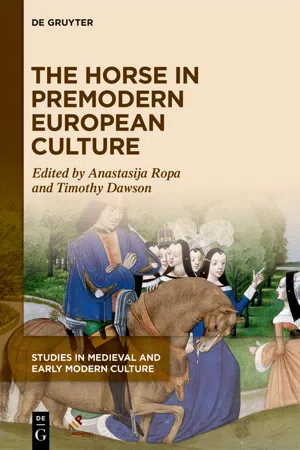
The Horse in Premodern European Culture
- 265 pages
- English
- ePUB (mobile friendly)
- Available on iOS & Android
The Horse in Premodern European Culture
About This Book
This volume provides a unique introduction to the most topical issues, advances, and challenges in medieval horse history. Medievalists who have a long-standing interest in horse history, as well as those seeking to widen their understanding of horses in medieval society will find here informed and comprehensive treatment of chapters from disciplines as diverse as archaeology, legal, economic and military history, urban and rural history, art and literature. The themes range from case studies of saddles and bridles, to hippiatric treatises, to the medieval origins of dressage literary studies. It shows the ubiquitous – and often ambiguous – role of the horse in medieval culture, where it was simultaneously a treasured animal and a means of transport, a military machine and a loyal companion. The contributors, many of whom have practical knowledge of horses, are drawn from established and budding scholars working in their areas of expertise.
Frequently asked questions
Information
Part I: Working Horses and Their Equipment
1 Equestrian Cities: The Use of Riding Horses and Characteristics of Horse Husbandry in Late Medieval Urban Agglomerations
Of Hooves, Heels, and Wheels
Interurban Mobility during the Eleventh and Twelfth Centuries
Sources and Methodology
Messenger service: Item des donnerſtdages 10ten dages Octobris geuen dem ſeluen arnolt zu bolchin zu Rydin 25 gr.9(Also given on Thursday 10th of October to the same Arnold for riding to Bollich 25 groats.) 10Diplomatic travel: Item geuen dem Rijchter zu paffenfaſſenacht do er zu dijdenhouen geryddin was nae den gevangen dije zu gors gevangen wurdin 11 gul 4 gr.11(Also given to the judge on Estomihi [= February 28, 1389], when he rode to Diedenhofen/Thionville to see after the prisoners who were taken at Gorze 11 gulden 4 groats.) 12
- Functions or services that necessitate traveling on horseback, including mounted messenger services, administrative tasks, diplomatic missions, military expeditions, and escorts;
- horse-related professions, such as horse traders, blacksmiths, veterinarians, saddlers and strap makers, spur and bit makers, horse slaughterers, and castrators;
- expenditures for horses, such as costs for horse rentals, fodder, housing, and horse gear; and
- data in conjunction with traveling on horseback, encompassing names, numbers, position, and social status of travelers as well as the quantity and quality of their horses,13 the motives for traveling, the point of departure, travel destination, travel duration, length of stay, traveling month, and the use of other means of transportation during the trips.

Table of contents
- Title Page
- Copyright
- Contents
- Introduction
- Part I: Working Horses and Their Equipment
- 2 Working Horses in the Northern European Countryside between the Thirteenth and Sixteenth Centuries: What Advantage for a Farm?
- 3 Baggage Animals – The Neglected Equines. An Introductory Survey of Their Varieties, Uses, and Equipping
- 4 Medieval Horse Harness – The Evidence of the Images
- Part II: Warhorses
- 6 The Use of the Crossbow in Medieval Cavalry
- Part III: Performing Horses
- 8 How to Ride before a Prince: The Rise of Riding as a Performance Art
- Part IV: Caring for Horses
- 10 Bread for My Horses
- Part V: Material Cultures of Riding
- 12 An Autopsy of Renaissance Equestrianism: The Materials, Making, and Use of a ca. 1535 War Saddle from the Musée des Beaux-Arts of Rennes
- Part VI: The Represented Horse: Law, Administration, and Literature
- 14 The Price and Value of the Warhorse in Late Medieval England
- 15 The (Galloway) Horse and His Boy: Le Roman Des Aventures De Fregus and “The Best Breed in the North”?
- Index of Personal Name
- Index of Place
- General Index